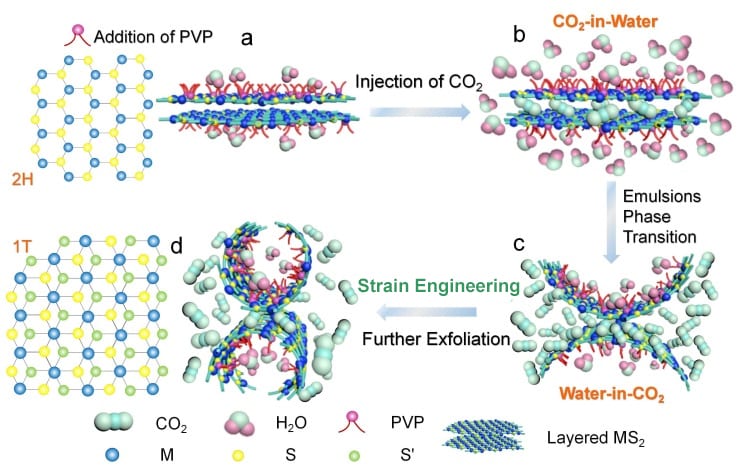 Hydrogen is a green fuel that does not generate carbon dioxide during combustion, and can thus play an important role in meeting the growing energy needs of the world. It is of great interest to utilize solar energy to produce hydrogen from renewable resources such as water. Although platinum and other precious metals are excellent catalysts for the hydrogen evolution reaction (HER), their application in large-scale hydrogen production is limited by their high cost and natural scarcity. Therefore, developing new earth-abundant catalysts is necessary. Molybdenum disulfide (MoS2) and tungsten disulfide (WS2) (MS2, M=Mo, W) are nontoxic, environmentally friendly and abundant semiconductors with the potential to fill this void.
Hydrogen is a green fuel that does not generate carbon dioxide during combustion, and can thus play an important role in meeting the growing energy needs of the world. It is of great interest to utilize solar energy to produce hydrogen from renewable resources such as water. Although platinum and other precious metals are excellent catalysts for the hydrogen evolution reaction (HER), their application in large-scale hydrogen production is limited by their high cost and natural scarcity. Therefore, developing new earth-abundant catalysts is necessary. Molybdenum disulfide (MoS2) and tungsten disulfide (WS2) (MS2, M=Mo, W) are nontoxic, environmentally friendly and abundant semiconductors with the potential to fill this void.
There is presently much effort in the field of 2D materials to explore the unique properties of layered MS2, which mainly exists in two phases: 2H and 1T. The metallic 1T phase is expected to exhibit promising HER catalytic activity, but is highly unstable in nature. Exploring an efficient route to fabricate a high degree of 1T phase is thus highly desirable. Electron-doping approaches, such as electron irradiation and lithium intercalation, have been employed to produce 2D 1T-MoS2. Unfortunately, several factors, such as the high temperature and tedious post-treatment of the residual lithium ions, have limited the scalable production and large-scale application.
In a recent article published in ChemNanoMat, Xu et al. reported a new strategy to create strain-tunable 1T-phase MS2 using supercritical CO2 (SC CO2)-induced reverse micelles. In the reverse-micelle-formation process, repulsion forces between hydrophilic groups and CO2 makes the hydrophilic groups aggregate and the micelles bend. Furthermore, the bending micelles lead to strained 2D single-layer MS2 nanosheets, which directly contribute to the successful transfer from 2H-MS2 to the 1T phase. The obtained 1T-MoS2 exhibits excellent stability and good activity for the hydrogen evolution reaction. A potential of ~330 mV at a current density of 10 mA/cm2 and a Tafel slope of 70 mV per decade were obtained for 1T-MoS2. Thus, this strategy utilizing a reverse-micelle-induced method for fabrication of 2D 1T-MS2 can widen the potential applications in photoelectrocatalysis and photoelectronic devices.
Text kindly provided by the authors of the original article.
















